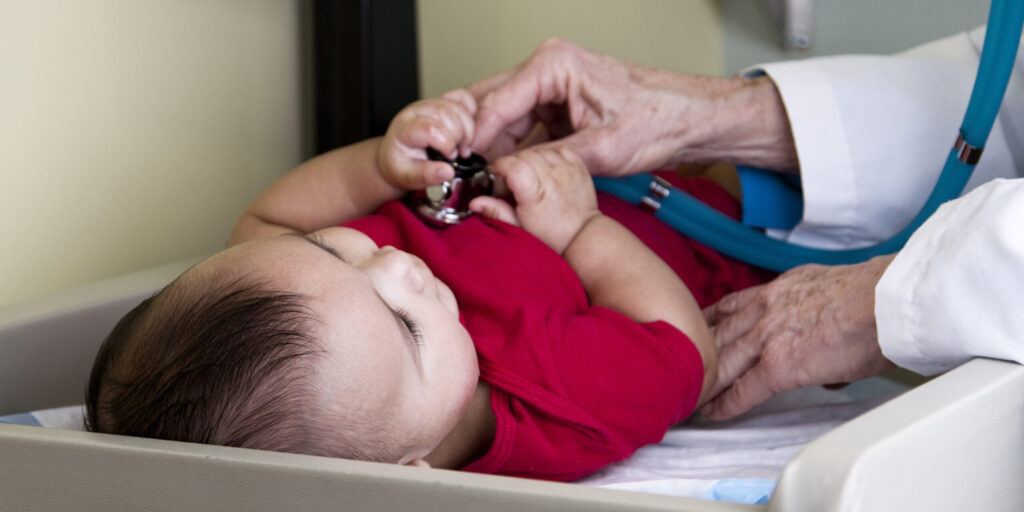
Understanding Hypotonia or Low Muscle Tone in Infants
By Myrna Traylor | Tuesday, August 15, 2023
Muscle tone is the amount of tension in muscles. Although it is not exactly the same as muscle strength, tone and strength often go together. This combination of tone and strength helps us hold our bodies upright and move around.
Hypotonia is a term used to describe extremely low muscle tone. Sometimes this condition is noticeable in newborn babies, or it may become more apparent as the infant grows older.
Muscle tone in babies can be very low for several reasons, including conditions like neuromuscular diseases in which the muscles are very weak.
What does hypotonia or “floppy infant syndrome” mean?

In his work, Carsten Bönnemann, MD, focuses on finding the causes of neuromuscular diseases that begin in infancy.
Carsten Bönnemann, MD, Senior Investigator of Neuromuscular and Neurogenetic Diseases of Childhood in the Neurogenetics Branch of the National Institutes of Health (NIH), explains that although we may not think of babies as “muscular,” a full-term newborn with average muscle tone and strength actually moves a lot.
“If you go into a baby nursery, you see how they kick their legs and move their arms around,” he says. “They have a flexed posture at the hips and lift their legs off the bedding. They may not have much motor control at this point, but they do move quite vigorously.”
In contrast, infants with hypotonia might be described as “floppy” or “limp.”
“You won’t see that typical repertoire of movements happening,” Dr. Bönnemann says. “The legs and arms are splayed down on the bedding and don’t move much. Often, along with that are problems feeding, swallowing, or breathing.”
This is sometimes called floppy infant syndrome in medical literature.
Causes of low muscle tone
When an infant shows signs of hypotonia, it’s important to find the cause as quickly as possible to identify treatments.
“The most common causes are actually not neuromuscular. For instance, hypotonia can be the result of an infection that leads to sepsis, hypoxia [low oxygen], ischemia [poor blood flow], heart failure, or encephalopathy [brain damage] — things that suppress the baby overall,” Dr. Bönnemann says.
Once doctors rule out an infection or other condition that needs immediate attention, they may begin to suspect a neuromuscular disease.
Many neuromuscular diseases can have infant hypotonia as a symptom. These include (but are not limited to):
- Congenital myopathies, such as X-linked myotubular myopathy and other centronuclear myopathies, nemaline myopathy, and core myopathies, such as central core and minicore myopathies
- Congenital muscular dystrophies (CMD), such as LAMA2-related CMD, collagen VI-related CMD, and alpha dystroglycanopathies
- Congenital myotonic dystrophy, particularly in infants of mothers with myotonic dystrophy type 1 (DM1)
- Metabolic muscle diseases, such as infantile Pompe disease, disorders of glycogen and lipid metabolism, and mitochondrial diseases
- Congenital myasthenic syndromes (CMS), which are genetic disorders of the neuromuscular junction
- Transient neonatal myasthenia gravis (MG), a disorder of the neuromuscular junction when a mother is affected by myasthenia gravis and passes disease-causing antibodies to the fetus via the placenta
- Congenital motor nerve disorders, such as early onset spinal muscular atrophy (SMA) and forms of motor nerve disease that primarily affect the legs (SMA LED)
- Congenital forms of Charcot-Marie-Tooth (CMT) disease, such as forms of Dejerine-Sottas disease and other forms of congenital hypomyelination of the peripheral nerves
Hypotonia also could be related to other genetic disorders that have similar symptoms to a neuromuscular disease but affect other parts of the nervous system, such as the brain and spinal cord. It’s essential to get an accurate diagnosis to determine the best medical management, prognosis, and potential availability of specific treatments and clinical trials, and for genetic counseling and family planning.
How to recognize hypotonia
Many cases of hypotonia are identified during the first hours, days, or weeks after birth when caregivers observe that an infant does not move their arms and legs and may have trouble sucking or swallowing. In other cases, it takes longer.
“Sometimes, the muscular hypotonia isn’t that dramatic or clear initially and is only recognized after the baby comes home and doesn’t meet motor milestones,” Dr. Bönnemann says.
Commonly missed milestones include:
- Lifting the head or controlling the neck muscles
- Rolling over
- Sitting up
“The diagnostic journey starts when the parents bring their baby to the pediatrician. Depending on the level of suspicion, the pediatrician may say, ‘Let’s wait and see,’ or refer the baby for specialist evaluation at a neuromuscular center,” Dr. Bönnemann says.
The diagnostic journey
In addition to careful clinical examination to determine if a neuromuscular disease is causing an infant’s hypotonia, an evaluation with a neuromuscular disease care team, such as at an MDA Care Center, may include more specialized testing.
Doctors might recommend one of these tests:
- Creatinine kinase (CK) test, a blood test that detects high CK levels, which may be a sign of muscle damage
- Electrical and imaging-based assessments of the muscles, neuromuscular junction, and nerves, such as electromyography (EMG), nerve conduction testing, ultrasound, and MRI
- Muscle biopsy, a procedure to remove a small piece of muscle tissue so it can be examined in a lab for signs of disease
- Genetic testing, which can include gene panel testing, whole exome sequencing, or whole genome sequencing (in special cases, this is done in the NICU as a rapid test). These genetic tests examine a person’s DNA for gene mutations known to cause disease.
Genetic testing
While genetic testing becomes more accurate and accessible every year, it does not always provide a clear genetic diagnosis.
“Sometimes you don’t find an answer from [genetic testing], or you get a partial answer,” Dr. Bönnemann says. “For instance, just one disease-causing variant is found when two would be needed to cause disease (as is the case in autosomal-recessive conditions) — or you get variants of uncertain significance, where the doctor and the team cannot determine whether they are causing or contributing to the disease seen in the child.”
For example, titin is one of the most difficult-to-interpret neuromuscular genes that can cause infant hypotonia. “The variant types are difficult to interpret because the titin gene makes the largest protein in the human body, and there are so many variants of uncertain significance,” he says. “That’s when the evaluation has to be escalated to a research center specialist to help make sense of a missing, incomplete, or uncertain genetic diagnosis.”
When it comes to genetic disease, an accurate diagnosis can lead to more proactive medical management and specific treatments where available. It also opens doors for patients to participate in clinical trials and other research to find treatments and cures.
“It’s more important to admit if the diagnosis isn’t genetically clear and to keep looking rather than saying, ‘Well, may you have this,’” Dr. Bönnemann says. “A misassigned genetic diagnosis is as much, if not more, of a problem as having no genetic diagnosis.”
Fortunately, many researchers are continuing to advance the science of genetic testing and diagnosis, including Dr. Bönnemann’s group at NIH, which is focused on finding the causes of neuromuscular diseases that begin in infancy.
“Our group here at the NIH is a resource for congenital-onset muscle disease or early-onset neuromuscular disease of any kind. If there is a child with undiagnosed or difficult-to-diagnose hypotonic disorder, then we can serve as a referral option (regardless of insurance coverage) using clinical assessment — including additional tests as needed, as well as genetic or genomic testing at a research level — to help arrive at a diagnosis for that child,” he says.
Next Steps and Useful Resources
- MDA Care Centers provide expert care for or individuals living with neuromuscular diseases.
- Get expert tips on how to navigate the diagnostic journey.
- Stay up-to-date on Quest content! Subscribe to Quest Magazine and Newsletter.
TAGS: Clinical Trials, Genetic Testing, Research
TYPE: Blog Post
Disclaimer: No content on this site should ever be used as a substitute for direct medical advice from your doctor or other qualified clinician.




